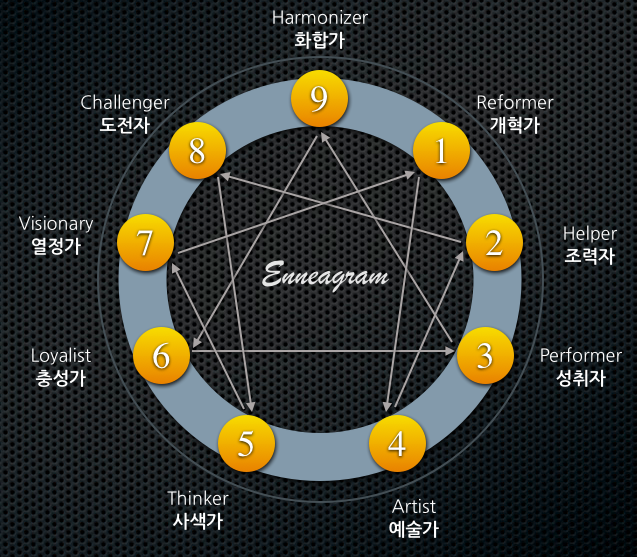
The Enneagram is a spiritual and psychological system that has been used for hundreds, possibly even thousands, of years in the Middle East and Asia.
It works around the Enneagram diagram to determine which fundamental personality type we are depending on for our core traits and characteristics.
Understanding our Enneagram type helps us to awaken and become consciously aware of our personality, the patterns we repeat and what triggers us.
The Enneagram theory is that when we are children beginning to navigate the world we find it safer to identify strongly with one personality type. As we grow older and become more confident and flexible we balance our personality by encompassing other traits.
Discovering our Enneagram personality type is beneficial as it provides a detailed insight into our personalities that allows us to look at our patterns of behavior that influence our personal lives, our relationships and also our working lives.
The restlessness we feel inside is not due to how much money we have, whether we have met the perfect partner or how well our careers are doing. This inner friction is because we have not yet discovered ourselves. Learning all about our intricate wiring is what helps us to assess the paths we should be heading down in all areas of our life. How can we possibly know where our destination lies if we haven’t first figured out whom we are and, secondly, where we truly want to be?
We have to go within before we realize we can go without. Nothing in the outer world will make us as content in the same way as listening to, fully acknowledging and understanding what is happening in our inner world.
What we think we know about ourselves is superficial and the reason for this is that it can be painful to accept the parts of ourselves we would prefer not to identify with at all. It is sometimes easier to turn a blind eye to our not so pretty traits and sugarcoat them on the surface, although, it is pointless as they will rise up when we least expect it.
While we are in denial and reject who we are at our core, we also deny anyone else the opportunity to get to know us fully and we will live in fear of their rejection should they ever witness our shadow side.
Rather than allowing a full connection we cause a separation and disconnect that ensures that we are not in touch with who we are and means that others only see the side we choose to portray to the outside world.
When we are in touch with all aspects of ourselves we find balance and become at one with who we are, rather than suppressing sides that are an intrinsic part of all human beings. When we are in control of our emotions and behaviors, it ensures our emotions and behaviors are not the ones controlling us.
Learning about ourselves is transformational as we become more consciously aware of how easy it is to access our healthier emotions and have our shadow emotions on a leash. When we live according to our own truth we can live in reality and not in an illusion.
It takes time to let go of who we are or who we have been so that we can become who we want to be. It is a process and one that does not seek perfection, but, instead, progression.
When we are answering questions about our personalities it is very easy to drift into thinking about how we would like to be rather than how we actually are. It isn’t easy to be brutally honest about how we think, feel and act so our perceptions of ourselves are sometimes based on the type of person we wished we were.
To gain results that are a direct reflection of who we are or who we have been previously, not who we perceive ourselves to be, it is essential that our ego steps out of the way. Then we can look at ourselves with clarity and make any changes that are required so that we can work on developing the traits that we want and hope to possess.
If you wish to take an Enneagram test to discover and learn more about your core personality here are the links:
For a shorter, free test click here.
For a longer, free test click here.
The tests determine which of the nine Enneagram types we identify with most strongly.
Each of the nine Enneagram personality types are identified with a number from one through nine.
1. The Reformer
Reformers are idealistic advocates for change, always looking to improve, reform and perfect things to achieve what they perceive to be the highest level of standards.
Traits: Ambitious, conscientious, dedicated, discerning, idealistic, independent, intelligent, high morals and values, noble, principled, perfectionist, problem-solver, purposeful, rational, realistic, self-controlled, wise. For a more detailed overview click here.
2. The Helper
As Helper’s are heart based types the main focus is on sincerity in both friendships and relationships.
Traits: Altruistic, caring, demonstrative, emotional, generous, high expectations, interpersonal, irrational, loving, nurturers, people-pleasing, possessive, practical, selfless, sensitive, sentimental. For a more detailed overview click here.
3. The Performer
Performers are achievers and they set out goals and targets for themselves and believe that when they meet these they will gain affection, approval and validation from others.
Traits: Adaptable, achievers, ambitious, attention seeker, charismatic, driven, energetic, excelling, fast learners, hard workers, image conscious, pragmatic, self-confident, successful, vain. For a more detailed overview click here.
4. The Artist
Artists are individualists, and see themselves as being different than everyone around them. They are often uniquely talented, highly skilled and gifted in the arts and they express themselves through their creative world and this is a main focus of their lives.
Traits: Artistic, creative, empathetic, expressive, dramatic, feeling unworthy, imaginative, individualists, introverts, intuitive, perceptive, self-absorbed, sensitive, temperamental, unique, withdrawn. For a more detailed overview click here.
5. The Thinker
Thinkers are able to see the world from new eyes and are often the visionaries and philosophers who open the world up to a new way of seeing things. They are curious and are constantly asking questions to be able to gain a new and unique understanding of how the world, everything in it, and beyond, works.
Traits: Alert, analytical, calm, cerebral, curious, devoted, independent, innovative, insightful, intense, investigator, isolated, minimalist, objective, perceptive, secretive, thinkers, withdrawn. For a more detailed overview click here.
6. The Loyalist
They are loyal to friends, relationships, family and their beliefs. There is nothing a loyalist wouldn’t do to support whatever it is they believe in. The main reason for their loyalty is their fear of abandonment. This fear ensures they make attachments to everything around them so that they have something to hold on to.
Traits: Appealing, anxious, assertive, committed, compassionate, compliant, dependable, faithful fearful, hardworking, intelligent, loyal, obedient, outspoken, reactive, responsible, security-orientated, suspicious, trustworthy, worrier. For a more detailed overview click here.
7. The Visionary
The Visionaries are also enthusiasts as everything is looked at through the eyes of adventure. They are fascinated with the world and see it as one giant adventure playground waiting to be explored.
Traits: Adventurous, acquisitive, busy, creative, distractible, dreamer, energetic, enthusiastic, entrepreneurs, extroverted, fun-loving, free-spirited, lively, optimistic, playful, scattered, spontaneous, versatile. For a more detailed overview click here.
8. The Challenger
Challengers are straight-talkers, although this can often come across as being blunt, abrasive and aggressive. Without realizing it they can be confrontational and intimidating when trying to put their point across.
Traits: Aggressive, assertive, blunt, confrontational, courageous, decisive, demanding, direct, dominating, independent, powerful, protective, self-confident, straightforward, strong willed. For a more detailed overview click here.
9. The Harmonizer
Harmonizers are peacemakers and they work to maintain both inner and external peace.
Traits: Accepting, agreeable, approachable, calm, creative, easygoing, optimistic, peaceful, non-judgmental, likeable, reassuring, receptive, resigned, supportive, tolerant, trusting, unassuming. For a more detailed overview click here.
The symbol for the Enneagram consists of a circle (representing zero) and nine lines.
The point touching the inner circle is identified with a number and each of these points is a personality type. The names of these personality types differ slightly between teachers and Enneagram references, but all have very similar meanings.
As our life alters and changes we will move around the circle, displaying emotions and behaviors relating to the different types, although it is believed that we always remain dominant within our original type.
Every human being encompasses the full range of the characteristics from the Enneagram chart, although we strongly identify with certain ones over others. Some characteristics lie dormant within us and when others surface we reject and deny them.
When we identify with a type on either side of our dominant one, it is known as a “wing.” For example if the dominant type is two with traits of type three, it would be identified as 2w3. If we identify with both groups on either side of our dominant one, our wings are said to be, “balanced.” For example, if the dominant type is two we also identify with type one and three, it is known as “2w1” and “2w3.”
The Enneagram is basically a map of the energy and movement of life. We step between the lines and dance around the symbol depending on the ebb and flow of life.
The Enneagram is not only a fascinating ancient map that helps us to understand ourselves, it also helps us to gain a valuable insight into the core personality of those important to us too. We can get to know ourselves and become fully present so that we can align our personal, love, professional and spiritual lives with what is written in the blueprint of our soul.
We have to unlearn everything that we, and others, have taught and conditioned ourselves to believe. We have to come to terms with all the stories and nonsense that has filled our mind and convinced us of who we are or who we should be, so that we can eventually start to become who it is that we really are.
Relephant:
Enneagram Personalities: The Challenger, The Harmonizer & The Reformer.
Enneagram Personalities: The Helper, The Performer & The Artist.
Enneagram Personalities: The Thinker, The Loyalist & The Visionary.
~
Author: Alex Myles
Editor: Travis May
Photo: Flickr/Jinho Jung
Bonus:
 Share on bsky
Share on bsky





Read 34 comments and reply